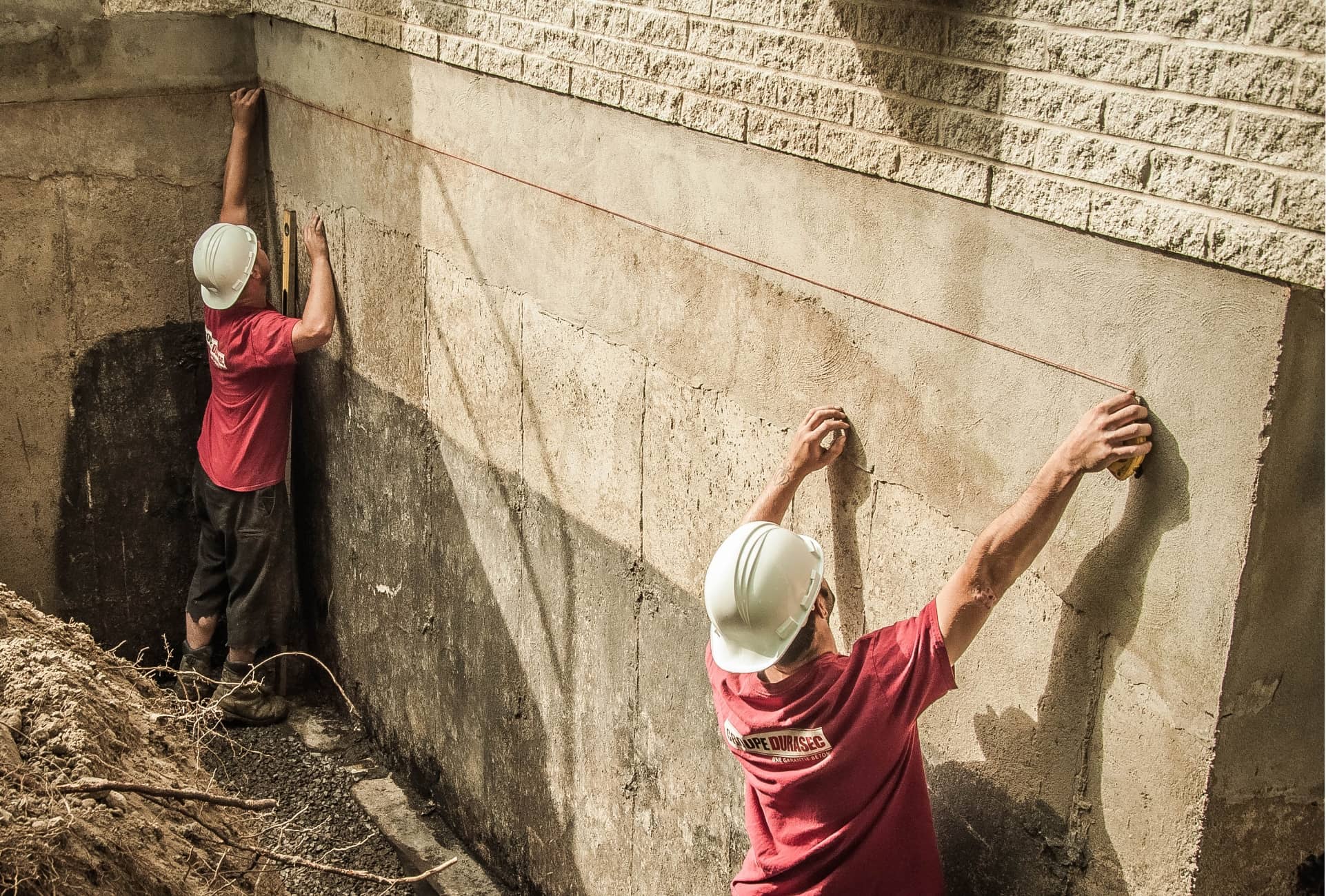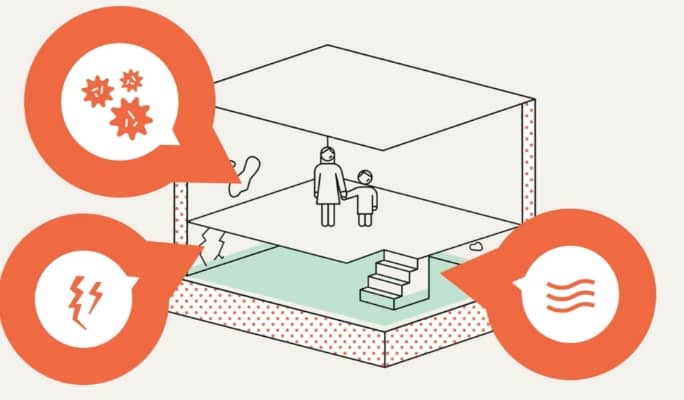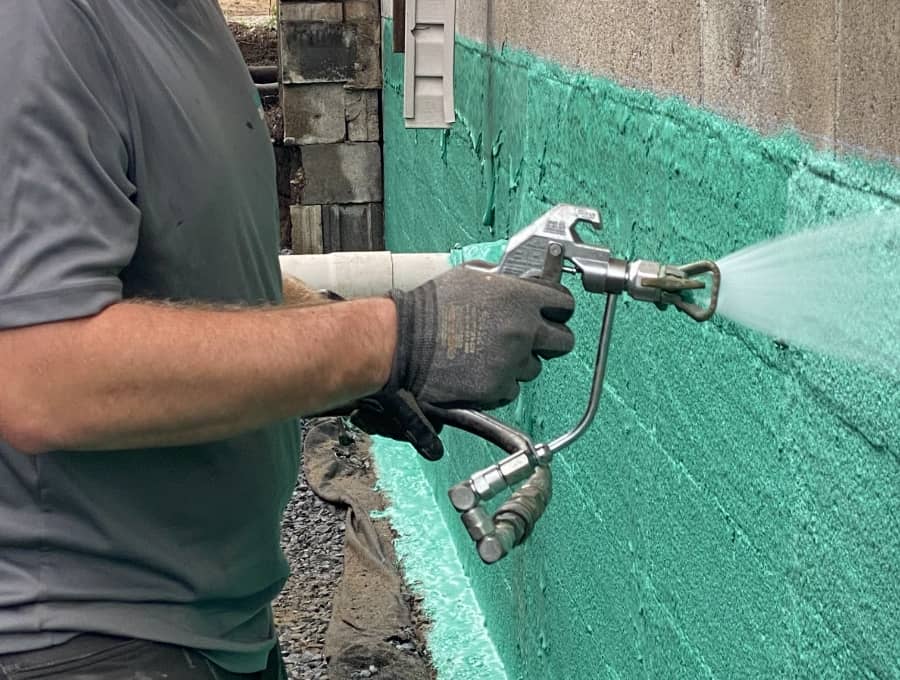Comprehensive solution
The comprehensive solution proposed by Groupe Durasec is the installation of an entirely waterproof membrane. The Rub-R-Wall membrane, guaranteed for 25 years and tested for a lifespan of 100 years, works together with a Geo-Wrap drainage composite, which protects it and directs water towards the French drain.
This proven system ensures that the amount of moisture in the concrete is reduced, at the same time minimizing foundation breakages and, especially, the humidity in your home.
We all know that humidity enables the growth of fungi.
Furthermore, the more humid the air is, the colder it gets! Many people think of insulating when their house is cold – they should also waterproof it!
Rub-R-Wall = Economical = Healthy = Ecological
The importance of tar-free membrane
Most membranes offered on the market use tar as a raw material. Even if they’re diluted with water or a solvent, they are ill-advised. Don’t let yourself be taken in by a salesperson who tells you their membrane is water-based! Water is the least waterproof component to use in making a membrane. And even though some use terms like “asphalt emulsion,” “modified emulsion,” or “rubberlike bitumen,” they really just mean tar.
A consequence of using tar: The gas contained in the tar evaporates into the ground, which makes the membrane lose all its physical properties.
The materials made using tar – asphalt, shingle, etc. – all deteriorate quickly. Tar-based membranes will therefore crack, come unstuck, and shrink, and will no longer prevent water and moisture from penetrating the concrete again.
This phenomenon occurs in the first three years of a new membrane… You can decide if that’s good enough!
Water infiltration
Having water in your basement is never a pleasant situation. However, there’s no need to panic – we have a solution to everything!
As soon as you notice water has come in, it’s important to start taking notes. These will help the specialist suggest the right repair solution for you. 1-2-3, it’s easy!
- Can you identify where the water is coming from? Mark that place on the top of the slab using white chalk or take a photo to compare the next infiltration to the last one.
- Do you see water dripping along the wall? If the answer is yes, you probably have a hole or a crack in the concrete of your foundation.
- Do you see water coming in where the foundation wall meets the slab? If the answer is yes, you probably have a problem with your French drain.
Iron Ochre
Iron ochre is made up of two bacteria that clog the drains and pump of a drainage system.
In this situation, you’re obligated to redo your four-inch BNQ drains to allow the required annual cleaning. For now, it’s the only solution that ensures the drainage system will be kept in acceptable condition to allow the evacuation of the water from the phreatic zone.
The required annual cleaning is performed using a commercial pressure washer that has at least 3,000 pounds of thrust. This allows you to operate a rotary nozzle that dislodges the iron ochre from the French drains for a certain amount of time.
A drain camera inspection will allow you to be 100% sure of the cleaning results.
The best option: call a professional to deal with the problem.
Cracking due to freezing
What to do to repair your foundation walls?
Concrete is an extremely solid material. However, the freezing it endures each winter can really put it to the test. In fact, water expands by 10% when it becomes ice.
A frost heave that takes root in the corner of an opening (window or door) can be inoffensive and may need only simple waterproofing. On the other hand, if the crack exceeds 1/8 in (3.3 mm), it may be a structural crack (insufficient soil reach) or cracking due to freezing. This type of crack, often horizontal, sometimes gives the impression that the wall is pushing towards the inside of the home and requires a more complex solution.
That’s when we must find the source of problem, get rid of it, and strengthen the structure (foundation wall) so that it can once again support the pressure put upon it by the ground.
Drainage for houses built on rock
When you buy land to build a house on, sometimes you discover that the ground is made of rock. Since blasting is expensive, some choose to pour the footings or the walls directly onto the rock. The slab is then poured directly onto the rock.
However, this situation creates a problem: there is no channel to direct the water towards a falling and extraction point (catch basin and pump). Since it’s essential to channel the water under a home, here are the corrective measures to take:
- Break the existing slab;
- Install peripheral drainage if the conditions are favourable along with a catch basin and a pump;
- Install drainage panels;
- Install insulation (if necessary);
- Install wire mesh;
- Put the concrete of the new slab into place.
For further information, call Groupe Durasec directly.
Big-o drain vs bnq drain
You think this choice doesn’t matter much? Think again!
The main disadvantages of the Big-O drain
- “Roller coaster” style of installation. Because it lacks rigidity due to its design, the draining is difficult to do.
- Crushing of the drain because it lacks rigidity. As a result, the drain no longer works correctly.
- It’s impossible to clean the drain correctly in a case of clogging caused by iron ochre. The grooves retain the sediments, preventing adequate cleaning.
- Fragile junction when uniting two Big-O drains.
- Perforation is too small for good cleaning when there’s clogging by iron ochre.
- It’s difficult to turn a corner at 90° during a camera inspection or to wash the drain because of the grooves. There’s a risk of clogging if you have iron ochre and you cannot clean it adequately.
The only quality of the Big-O drain is its initial price. Unfortunately, its many disadvantages can cost you a fortune in the long run.
In 2010, faced with that reality, Groupe Durasec was the first company to decide to install only four-inch BNQ-type pipes on all of its jobs.
- Risk of installation error reduced to the minimum
- Necessary rigidity for this type of work
- Perforation of 13mm allowing good drain cleaning
- Smooth pipe interior
- Parts that stick together
- Pipe approved by Groupe Durasec and guaranteed for 25 years with a planned 100-year lifespan
Window well
The window well creates a safe space to keep water from coming in from the window and rotting. It must not exceed the ground by more than three inches or be unsightly. The most important thing to check is the degree of incline of the land and the distance between the level of the ground and the bottom of the window – any adequate installation would take these two factors into account.
Bi-annual cleaning is required: one in the spring and the other in the fall during your seasonal chores.
If the stone of the vertical pipe is contaminated by fine particles (earth, sand, debris from leaves), you can use a garage vacuum cleaner to remove the stone ¾ and the debris. However, don’t forget to put back the stone ¾ once the process is over. For further information, call Groupe Durasec directly.
For further information, call Groupe Durasec directly.
How to read a technical data sheet?
Do you need a particular product? Go and read its technical data sheet before buying that product. It’s full of information that can shed some light on your choice!
What you must know before buying a membrane:
- Is the raw material that makes up the product tar-free?
- Is it durable? The length of the guarantee will give you many clues about its longevity.
- Is it sprayed to even out the roughness of the concrete?
If you answered yes on these three points, that’s a good sign.
Rub-R-Wall technical data sheet
Foundation with insulating formwork
Homeowners who decide to build their foundation using the anti-freeze technology of insulating formwork are making an excellent choice! If the house is built entirely of this material, that’s even better! It’s actually one of the best options in building a green, ecological home that will minimize the effects of global warming.
On the other hand, it’s important to protect your investment by applying Rub-R-Wall superior protection.
In general, companies suggest putting in a self-adhesive membrane. However, our tests have proven that this type of membrane is not adequate protection, because it loses its effectiveness in only two years.
Slim line membrane or polyethylene film
Both of these solutions contain petroleum, which evaporates over time and alters their physical properties. In fact, polyethylene, used in most modern construction projects, lasts only 10 years. Slim-line, though, has an estimated lifespan of 200 years! During that period, it will remain effective and will keep moisture from passing through concrete slabs in the basement. The Slim-line membrane also forms an additional barrier in the fight against the radon gas naturally contained in the ground.
The choice is yours!
Pyrite
If you’ve never heard of pyrite, it might mean you haven’t been living in Quebec these past 20 years, because nothing has created as much discussion in the housing sector as this mineral has. This phenomenon was unheard of before the early 70s, when many properties in Canada were suffering from this scourge. In Quebec, the first cases of pyrite were recorded only starting in 1985. The news spread through the media in 1998.
What is pyrite?
Pyrite is a mineral consisting of iron sulfide. Completely inoffensive in nature, it becomes extremely harmful when it ends up in the aggregates used in manufacturing concrete or in foundation backfilling. This mineral becomes a problem when, in contact with water and air, it starts to swell to the point where it can cause cracks in the basement slab and the foundation walls. In general, the phenomenon occurs in the 5 to 10 years after construction.
How to solve pyrite-related problems?
It’s critical to have a specialist inspect cracking or swelling in your slab or in your foundation walls. To determine if it’s actually pyrite, the specialist conducts an examination and an analysis of the concrete and the backfill. If pyrite is the culprit, the only solution is to remove the contaminated slab, foundation walls, or backfill to replace them with backfill or concrete that is certified “DB,” which has been the mandatory standard for these materials since 1999.
With Durasec, you can have your pyrite-related problems solved. We are specialists in decontamination and in foundation repair.
We also offer you a chance to take advantage of our RÉNO-PYRITE guarantee from APCHQ.


